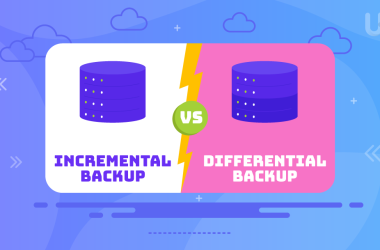The concept of Disaster Recovery has become an indispensable component for ensuring the resilience and continuity of organizations. As businesses increasingly rely on digital infrastructure and data-driven processes, the potential impact of unforeseen disasters has heightened, making Data Backups a critical aspect of strategic planning.
At its core, Disaster Recovery refers to the set of policies, tools, and procedures that enable the restoration of vital systems, applications, and data after a disruptive event. These events can range from ransomware attacks to even human errors leading to data loss. Moreover, the ultimate goal of Disaster Recovery is not just to recover data but to ensure the swift restoration of normal business operations.
Understanding Disaster Scenarios
Disasters come in various forms, each posing unique challenges to the stability and continuity of business operations. A comprehensive Disaster Recovery plan begins with a thorough understanding of the different scenarios that can disrupt the normal course of business.
Different Types of Disasters
- Human Error and Accidents: Despite technological advancements, human error remains a significant factor in disaster scenarios. Accidental deletion of critical data, misconfigurations, or even physical accidents in data centers can lead to data loss. Recognizing the potential for human error and implementing safeguards, including training programs and strict access controls, is integral to a robust Disaster Recovery strategy.
- Cybersecurity Threats: In an era dominated by digital connectivity, cybersecurity threats have become a prevalent concern. Ransomware attacks, in which malicious actors encrypt an organization’s data and demand a ransom for its release, can cripple operations and compromise sensitive information. Understanding the evolving landscape of cybersecurity threats is crucial for implementing effective measures to prevent malware attacks.
Impact of Disasters on Data and Business Operations

Data Loss
One of the primary consequences of disasters is the potential loss of critical data. Whether due to physical damage, cyber attacks, or human error, the irreplaceable nature of data underscores the importance of comprehensive backup strategies. Moreover, data loss can have far-reaching implications, affecting not only operational efficiency but also customer trust and regulatory compliance. For businesses seeking reliable hard drive recovery solutions, partnering with experts can ensure swift restoration of critical data and minimize operational disruptions.
Downtime
Disasters often lead to disruptions in business operations, resulting in downtime. The longer an organization remains inactive, the greater the financial and reputational consequences. Downtime can be especially detrimental in industries where continuous availability is imperative. Effective Disaster Recovery plans aim to minimize downtime by ensuring swift data recovery and system restoration.
Financial Consequences
The financial impact of disasters extends beyond immediate recovery costs. Businesses may face revenue loss, regulatory penalties, and increased expenses associated with recovery efforts. Additionally, the long-term effects on customer loyalty and market position can have enduring financial repercussions. Understanding and quantifying these potential financial consequences are critical for prioritizing investments in Disaster Recovery measures.
The Role of Data Backups
In Disaster Recovery, the pivotal role of Data Backups emerges as a beacon of resilience, offering a lifeline to organizations grappling with the potential fallout of unforeseen disasters.
Creating Copies of Critical Data
At its essence, Data Backups involve the meticulous creation of duplicate copies of critical information. This process extends beyond mere replication; it entails safeguarding the integrity and completeness of data to ensure that, in the event of a disaster, organizations can seamlessly restore their operational foundations. Moreover, by preserving these copies, businesses inoculate themselves against the irreparable loss that can accompany data corruption or destruction.
Storing Backups in Secure Locations
The location of data backups is as crucial as the act of creating them. Storing backups in secure, offsite locations shields them from the very disasters they are designed to mitigate. Whether through physical means like fireproof safes or digital sanctuaries such as secure cloud storage, the emphasis is on creating a resilient fortress for WordPress data backups, impervious to the perils that might befall the primary data repositories.
Types of Data Backups
Full Backups
A Full Backup involves duplicating the entirety of the organization’s data at a specific point in time. While comprehensive, this method requires substantial storage space and can be resource-intensive. Moreover, full backups serve as a baseline for recovery, ensuring that every piece of data is available for restoration.
Incremental Backups
Incremental backups capture only the changes made since the last backup, significantly reducing storage requirements compared to full backups. While efficient in conserving resources, restoring data may involve multiple incremental backups, starting from the last full backup. This method ensures a balance between resource utilization and restoration efficiency.
Differential Backups
Differential backups, like incremental, capture changes since the last full backup. However, unlike incremental, they store all changes made since the last full backup, simplifying the restoration process. While requiring more storage than incremental, differential backups provide a middle ground between full and incremental approaches.
Supercharge Your Disaster Recovery Plan Today!
Explore our cutting-edge NVMe VPS solutions and fortify your business’s data resilience. Elevate your disaster recovery strategy with automated daily backups, full server snapshots, and 1-click restore for your website.
Best Practices for Data Backup
Regular Backup Schedules
The effectiveness of Data Backups lies in their regularity. Establishing consistent backup schedules ensures that the most recent data is always available for recovery. Moreover, the frequency of backups should align with the criticality of the data and the pace of changes within the organization.
Verification and Testing
The reliability of backups must be routinely verified through testing. This involves simulating recovery scenarios to confirm that the backup process is functioning as intended. Moreover, regular testing not only instills confidence in the backup system but also exposes any potential issues that may impede a smooth recovery.
Offsite and Cloud Backups
Diversifying backup storage locations is a fundamental principle of resilience. In addition to on-premises backups, maintaining copies in offsite locations or leveraging secure cloud storage enhances protection against physical disasters. Cloud backups, in particular, offer scalability, accessibility, and often advanced security features, making them an integral component of modern Data Backup strategies.
Implementing a Disaster Recovery Plan
The transition from theoretical understanding to practical application of Disaster Recovery involves the development and implementation of a comprehensive strategy. This strategic blueprint not only orchestrates the recovery of data but also ensures the restoration of critical systems, minimizing downtime and fostering a swift return to normal business operations.
As a pivotal element in securing online transactions and data integrity, the incorporation of an SSL certificate into the Disaster Recovery plan further enhances the security posture. This ensures that during the recovery process, data encryption and secure transmission contribute to a seamless restoration of digital operations.
Developing a Comprehensive Disaster Recovery Strategy
Identifying Critical Systems and Data
The foundation of a robust Disaster Recovery plan lies in the meticulous identification of critical systems and data. This involves a thorough analysis of the organizational landscape to pinpoint the components that are essential for day-to-day operations. Moreover, by categorizing systems and data based on their criticality, businesses can tailor their recovery efforts to prioritize the most vital assets.
Prioritizing Recovery Processes
Not all systems and data are created equal, and neither are the recovery processes associated with them. Prioritization is key. A comprehensive Disaster Recovery strategy involves categorizing recovery processes based on urgency, potential impact on operations, and dependencies. Moreover, this ensures that resources are allocated efficiently, focusing first on the elements crucial for the organization’s immediate functionality.
Challenges in Data Backup and Disaster Recovery
While the implementation of Data Backup and Disaster Recovery plans is imperative, organizations often face a myriad of challenges that can undermine the effectiveness of these strategies. One crucial aspect in fortifying disaster preparedness involves investing in DDoS protected VPS solutions. Recognizing and mitigating these challenges, particularly in the realm of cybersecurity, is essential to ensure the resilience and success of overall disaster preparedness efforts.
Inadequate Backup Frequency
One of the common pitfalls in Data Backup strategies is the infrequency of backups. Organizations may fall into the trap of assuming that periodic backups are sufficient. However, this approach leaves a significant window for data loss, especially in dynamic environments where information is constantly changing. Moreover, it is crucial to align backup frequencies with the pace of data changes, ensuring that the most recent and critical information is always safeguarded.
Lack of Testing
Regular testing of backup and recovery processes is a cornerstone of a reliable Disaster Recovery plan. Some organizations make the mistake of neglecting this crucial step, assuming that the mere existence of backups guarantees their effectiveness. Without periodic testing, the true functionality of the recovery processes remains unverified, potentially leading to unforeseen challenges and delays during an actual disaster.
Ignoring Human Factors
Human error is an ever-present threat, and organizations sometimes overlook the human element in disaster scenarios. Inadequate training, improper access controls, or a lack of awareness about the importance of Disaster Recovery can contribute to vulnerabilities. Moreover, failing to account for human factors can result in accidental data loss or hinder the swift execution of recovery procedures.
Cybersecurity Challenges
The digital landscape is dynamic, and cybersecurity threats are continually evolving. Traditional methods of securing data may become obsolete in the face of sophisticated cyber attacks, such as ransomware or advanced persistent threats. Organizations must stay vigilant, continuously updating their security measures to counter emerging threats. Moreover, the interplay between cybersecurity and web hosting becomes crucial as cyber threats can directly impact the integrity and availability of data.
Conclusion
In conclusion, organizations equipped with proactive Disaster Recovery measures and robust Data Backups not only weather unforeseen challenges but also proactively shape their resilience. In a world where uncertainties are inevitable, strategic preparedness emerges as the beacon guiding businesses toward sustained stability and continuity.
To avoid stress with making backups, get secure and safe WordPress Hosting with automatic daily backups and obtain 24/7 support from our support team. Our powered infrastructure focuses on auto-scaling, performance, and security.
FAQ
How often should organizations test their Disaster Recovery plans?
Organizations should test their Disaster Recovery plans regularly to ensure the functionality of backup and recovery processes. Moreover, testing helps identify potential issues and ensures a smooth recovery in actual disaster scenarios.
What is the significance of Data Backups in Disaster Recovery?
Data Backups play a pivotal role in Disaster Recovery by creating duplicate copies of critical information. This ensures that, in the event of a disaster, organizations can restore lost or compromised data, reducing the risk of data loss and facilitating a quick return to normal business operations.
Why is Disaster Recovery essential for businesses?
Disaster Recovery is crucial for businesses to ensure continuity in the face of unforeseen events such as natural disasters, cyber threats, or human errors. It involves comprehensive strategies to recover critical systems and data swiftly, minimizing downtime and financial impact.
Why is offsite and cloud backup important in Disaster Recovery?
Offsite and cloud backups provide additional layers of protection by storing duplicates of data in secure locations. Moreover, this ensures data integrity and availability, even in the face of physical disasters affecting on-premises infrastructure.












